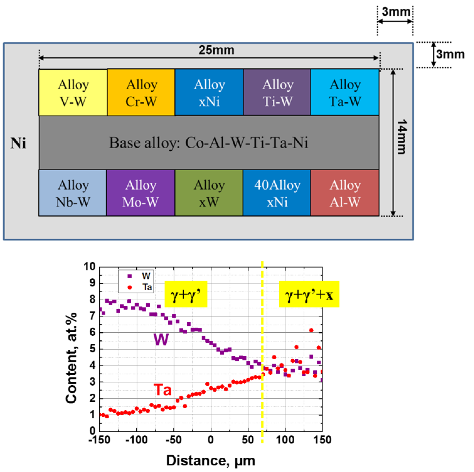Design and Optimization of Novel Cobalt-base Superalloys based on Multi-component Diffusion Multiple
Li Longfei*, Li Wendao, Zhuang Xiaoli, Zoumin, Feng Qiang
Beijing Advanced Innovation Center for Materials Genome Engineering, State Key Laboratory for Advanced Metals and Materials, University of Science and Technology Beijing, Beijing 100083, China
EXTENDED ABSTRACT: Compared with nickel-base superalloys, cobalt-based superalloys have higher melting temperature and excellent corrosion resistance, thermal fatigue resistance, castability and weldability. It still has certain advantages under complex service conditions, but the lack of γ' -strengthening mechanism limits its engineering application. In 2006, γ'-Co3(Al,W) phase with dissolution temperature close to 1000 oC was found in co-Al-W-base alloy by researchers of Tohoku University, which is about 200 oC higher than that of traditional cobalt-base superalloy [1]. Compared with nickel-base superalloys, the basic data of novel γ'-strengthened cobalt-base superalloys is insufficient and the alloying principle needs to be clarified. In order to promote the engineering application of this kind of alloy, our team develops the multi-component diffusion multiple technology with the help of Prof. JC Zhao of the Ohio State University, according to the alloy characteristics and objectives of the service environment demand, as shown in figure 1. The technique breaks through the limitation that only one data point can be obtained from a single sample, and efficiently establishes a quantitative relational database of alloy composition, phase equilibrium and microstructure stability (including more than 5000 sets of experimental data). On this basis, the relationship model between alloy composition and long-term microstructure stability was established by machine learning technology. According to the microstructure reverse design concept and multi-objective optimization strategy, a new method for composition design and optimization of γ'-strengthened cobalt-base superalloyd was established, and was verified for different application scenarios.

Figure 1. Cross-sectional schematic of the diffusion multiple
REFERENCES
[1] J. Sato, T. Omori, K. Oikawa, I. Ohnuma, R. Kainuma and K. Ishida, Science, 312 (2006) 90-91

Li Longfei, P.H. D., graduated from University of Science and Technology Beijing in 2005. Now he is an associate professor and doctoral supervisor of the State Key Laboratory of Advanced Metal Materials, University of Science and Technology Beijing. He has been committed to basic research on alloying principle, microstructure control mechanism and microstructure-high temperature/room temperature mechanical properties of advanced metallic structural materials, and has rich experience in composition design and optimization of advanced nickel-base/novle cobalt-based superalloys. He has published more than 80 articles and has got 11 patents.